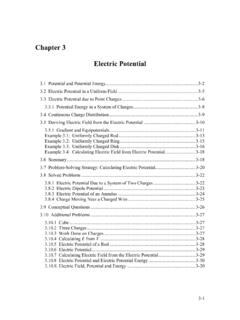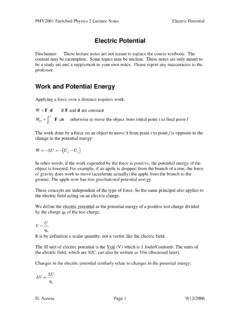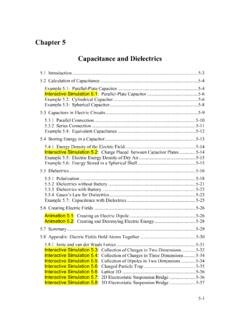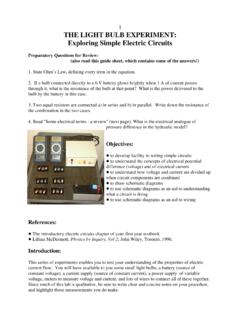Electric Potential Difference
Found 9 free book(s)(a)€€€€ Define the electric potential at a point in an ...
umutech.net(ii)€€€€€State how you would use the graph to find the electric potential difference between the points A and B. _____ _____ (1) E 7 KHS HUPLWWLYLW\R II UHHV SDFH00 is 8.9 × 10–12 F m–1. (i)€€€€€€Calculate the total charge on the Earth. ...
Chapter 3 Electric Potential - MIT
web.mit.eduThe potential difference ∆V represents the amount of work done per unit charge to move a test charge from point A to B, without changing its kinetic energy. Again, electric potential should not be confused with electric potential energy. The two quantities are related by q0 ∆Uq=∆0 V (3.1.10) The SI unit of electric potential is volt (V):
Electric Potential Work and Potential Energy
www.phys.ufl.edupotential energy of a particle like the electron crossing an electric potential difference. Consider an electron crossing a potential difference of 1 volt: This is a tiny number, which we can define as one electron-volt (abbreviated “eV”).
Motion of Charged Particles in Electric and Magnetic Fieldsx
www.subhasishchandra.comElectric field between two parallel plates having a potential difference of V volts and having separation d metres between them is given as E= / The SI unit for Electric field is Newtons/Coulomb (N/C). Electric Potential: Electric potential (V) at a point is defined as the work done on a positive charge to bring it from infinity to that point.
Lecture 4 Electric Potential - Cornell University
courses.cit.cornell.eduElectric Potential In this lecture you will learn: • Electric Scalar Potential • Laplace’s and Poisson’s Equation ... • The line integral of E-field between any two points is the difference of the potentials at those points ()() 1 2 2 1 2 1 E.ds.ds r r r r r r r r r r r r r r r
Chapter 5 Capacitance and Dielectrics
web.mit.eduproduces a potential difference. Find the capacitance of the system. Figure 5.2.1 The electric field between the plates of a parallel-plate capacitor Solution: To find the capacitance C, we first need to know the electric field between the plates. A real capacitor is finite in size. Thus, the electric field lines at the edge of the plates are not
1 THE LIGHT BULB EXPERIMENT: Exploring Simple Electric ...
faraday.physics.utoronto.caPotential difference or voltage: this has to do with the "push" on charges that the electrical force has between two points in a circuit. More clearly, it is the difference in potential energy that a 1 Coulomb charge experiences in being transferred between the two points in the circuit that are being compared. Units are Joules/Coulomb = Volts.
Electric Potential Difference, - Physics Courses
courses.physics.ucsd.eduA parallel plate capacitor has a constant electric field of 500 N/C; the plates are separated by a distance of 2 cm. Find the potential difference between the two plates. Example of Potential Difference + + + + + + + _ difference _ _ _ _ _ _ ΔV Remember: potential ΔV does not depend on the presence of any test charge in the E-field! d
Electric circuits, Current, and resistance (Chapter 22 and 23)
www.physics.brocku.caA current density J & the electric field E are established in a conductor when a potential difference (Vb-Va) is maintained across the conductor J = σE -----Ohm’s Law σ is called electrical conductivity of the materials Ohmicmaterials: In these materials the ratio of J and E is a constant “σ”. In other words, it is J








